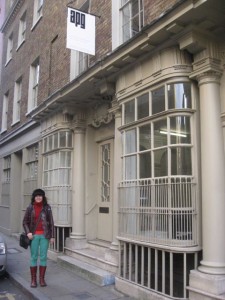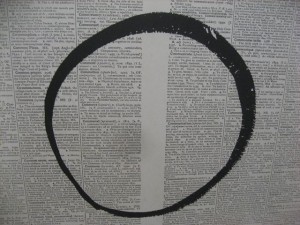Friday December 7th ‘The Politics of the Archive’.
Last night, I went to the final Public Event on the APG Show at Raven Row, on the Archive, which is of course amazingly relevant to what I am doing.
The Politics of the Archive. Thursday 6 December, 6.30pm.(From Raven Row Press Release)… “Archives can trigger memories and also reconfigure meanings, destabilising the production of history by creating new readings. Derrida writes in Archive Fever that the politics of the archive can never be determined. He remarks that there is no political power without control of the archive. This final ‘sculpture’ focuses on the archive’s potential to unearth specificities, and question what is fact or fiction. A short panel introduction with Antony Hudek, Victoria Lane, Jo Melvin, Gustavo Grandal Montero and Neal White will lead into five group discussions taking place throughout the exhibition.”
I joined Neal White’s discussion group -Neal is a member of ‘O+I’, which APG later became, and has done much of the archiving of the APG for Tate, and he has been very helpful to me in the course of my research. There was much discussion about the worth and legacy of APG, and how this is revealed (or not) through the Archive, and the Raven Row show. Neal talked about the ‘template’ of the APG to take forward into the future, and what this should be. There is still the need for a feminist critique of APG-(which Claire Bishop discusses in the new text, “Artificial Hells”, about the politics of participation and spectatorship). In the Archive, the content is not necessarily the material . The material is presented to you and you are allowed to critique it. Neal White talked about the current APG Archive being a partial view, stopping around 1978 , with more episodes to follow, and questioned whether criticism of the APG was represented in the Raven Row Show. For instance, artist Stuart Brisley, who had an ideological fall-out with APG, withdrew from the Show. He disliked the term ,”Incidental Person” rather than Artist, believing ‘incidence’ meant something else and should be changed.
Jo Melvin’s Group talked about the excitement and exhilaration for a quest that can never be completed.
Antony Hudeck’s Group asked who was pulling the pursestrings of APG and the archive impetus. APG’s methodology is archival. and becoming increasingly so with time. He also talked very eloquently about “What is Legacy?”, what does it mean? What is the meaning “that will resist this corrosion of stories?” Can the Archive be relied on to preserve the ‘truth’?
It was felt this was the first event of the future of APG, marking a moment for the past and future simultaneously. This is a similar time yet again, and there is huge interest from the current generation in what it has to offer.The Raven Row show is an important event for what happens next.
Someone suggested publishing the Archive and turning it into an Instruction Manual for Artists! -and using it as a vehicle for collective possibility and disruption, as a blueprint for what should be going on in the art world. Neal White suggested the Artist Replacement inside the Archive, finding ways of using it creatively, ‘contaminating’ or disrupting it. He talked about creating a temporary space with a facsimile archive, with things inserted, intervening and making new histories for it.
The Archive is a body of material. Barbara Steveni wants us to get away from this and free ourselves from something so subject to memory and feeling-hence her oral histories and narrative projects,”I Am An Archive” and the exhibition at the Arnolfini titled “Beyond the Acid-Free”. She talked about the dilemma of what to keep and what to destroy.
The Archive is:
THE STUFF
ENERGY
ENERGY+THE STUFF=NEEDS ACTION.
Barbara Steveni also talked about the excitement she felt in the interest from the Universities !.(This is where I could really develop something for University of Salford.)
The concluding questions are thus:-Who is the Archive For? How can it be made accessible to those who don’t know it exists. Artists working in the field need to see it, it needs to be presented to a lot of different audiences.
HOW?
WHO FOR?


